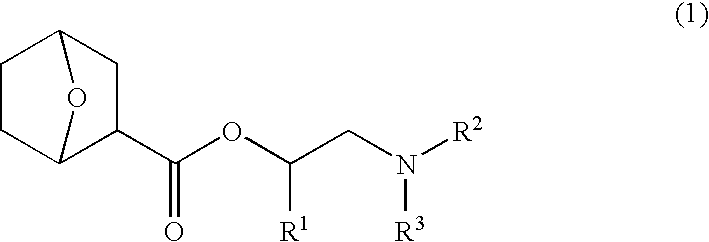Nitrogen-containing organic compound, chemically amplified resist composition and patterning process
a technology of chemical amplification and organic compound, which is applied in the direction of rain/draught deflector, photosensitive materials, instruments, etc., can solve the problems of reducing the final dimension of the pattern line, the practical use of chemical amplified resists, and the line pattern, etc., to achieve satisfactory profile, high resolution, and high resolution
- Summary
- Abstract
- Description
- Claims
- Application Information
AI Technical Summary
Benefits of technology
Problems solved by technology
Method used
Image
Examples
example
[0203]Examples of the invention are given below by way of illustration and not by way of limitation. The meaning of abbreviations is Me for methyl, and Ac for acetyl.
synthesis examples
[0204]Nitrogen-containing organic compounds within the scope of the invention were synthesized by the method described below.
synthesis example 1
Synthesis of nitrilotriethane-2,1-diyl tris(7-oxanorbornane-2-carboxylate) (Amine 1)
[0205]
[0206]To a mixture of 149 g of triethanolamine, 405 g of triethylamine, and 1,500 g of methylene chloride at 5-10° C., 506 g of 7-oxanorbornane-2-carboxylic chloride was added dropwise over 2 hours. The mixture was then stirred for 10 hours at 25° C. Water was added to the reaction mixture to stop the reaction, followed by conventional aqueous work-up and purification by column chromatography. There was obtained 469 g of nitrilotriethane-2,1-diyl tris(7-oxanorbornane-2-carboxylate) (yield 90%).
PUM
| Property | Measurement | Unit |
|---|---|---|
| wavelength | aaaaa | aaaaa |
| temperature | aaaaa | aaaaa |
| thickness | aaaaa | aaaaa |
Abstract
Description
Claims
Application Information
 Login to View More
Login to View More - R&D
- Intellectual Property
- Life Sciences
- Materials
- Tech Scout
- Unparalleled Data Quality
- Higher Quality Content
- 60% Fewer Hallucinations
Browse by: Latest US Patents, China's latest patents, Technical Efficacy Thesaurus, Application Domain, Technology Topic, Popular Technical Reports.
© 2025 PatSnap. All rights reserved.Legal|Privacy policy|Modern Slavery Act Transparency Statement|Sitemap|About US| Contact US: help@patsnap.com



